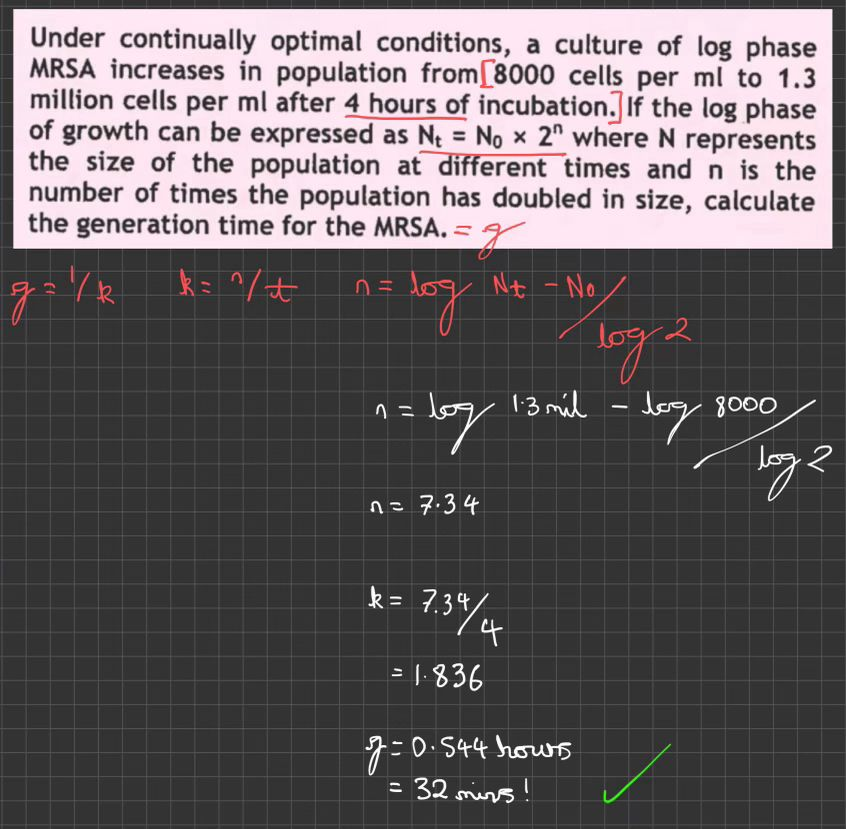Bacteria & Basic Bacteriology
1/33
There's no tags or description
Looks like no tags are added yet.
Name | Mastery | Learn | Test | Matching | Spaced |
|---|
No study sessions yet.
34 Terms
Name the mnemonics created to memorise Gram Positive & Negative Bacteria list [EXAM MCQs → Multiple]
Gram Positive Cocci: End in COCCI
Lactococci
Staphylococci
Streptococci
Viridians
Enterococci
Gram Negative Cocci:
Neisseria
—
Gram Positive Bacilli: Follow BACILLI spelling
Bacillus
Actinomyces
Clostridium
Corynebacterium
Listeria
Gram Negative Bacilli: All end in ELLA
Salmonella
Shigella
Legionella
Klebsiella
Bordetella
Brucella
Francisella
Pasteurella
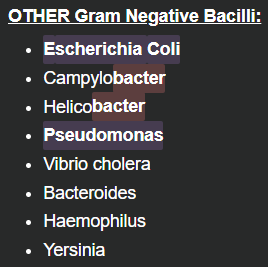
What is artificial acquired active immunity in the context of bacteria
"Artificial acquired active immunity is immunity gained through vaccination, where a modified bacterial antigen is introduced to stimulate the immune system to produce antibodies and memory cells without causing severe disease."
How is bacterial nomenclature formatted
1) Genus is italicized with an uppercase first letter (e.g., Neisseria), species is italicized and lowercase (e.g., gonorrhoeae)
2) Genus can be abbreviated (e.g., N. meningitidis) when multiple species are named.
3) Condition is not italicized and lowercase unless at the START of a sentence (e.g., gonorrhoea)
How is the full name of a bacterium written initially and abbreviated later
"The full name is written first (e.g., Neisseria gonorrhoeae), then abbreviated by using the first letter of the genus followed by the species (e.g., N. gonorrhoeae), with an underline over the genus name initially."
Drug impacts on bacteria
Bactericidal - Inhibition of Cell Wall Synthesis [Prevents peptidoglycan cross-linking, leading to bacterial cell lysis.] By Beta-lactams (Penicillins, Cephalosporins, Carbapenems, Monobactams) such as Amoxicillin, Flucloxacillin, Ceftriaxone
Bacteriostatic - Tetracyclines (Doxycycline, Tetracycline) 30S inhibitors
OR Chloramphenicol 50S inhibitors
Inhibition of DNA/RNA Synthesis - Fluoroquinolones (Ciprofloxacin, Levofloxacin), OR Metronidazole: Produces free radicals → DNA damage
OR Rifamycins (Rifampicin): Inhibit RNA polymerase
Inhibition of Folic Acid Synthesis - Sulfonamides & Trimethoprim (Co-trimoxazole): Block folic acid metabolism → DNA synthesis.
What are the shapes of bacteria based on cellular morphology
Cocci (circular, e.g., coccus, diplococci [2 cocci])
Bacilli (rod-shaped, e.g., streptobacilli, bacillus)
Others (spirochete, Y-shaped, helical); bacteria rarely exist alone.
How do bacteria reproduce
"Bacteria reproduce asexually via binary fission (2 to 4, 4 to 8, etc.), dividing along different planes to form chains (streptococci), tetrads, or clumps (staphylococci)."
What is the size range of bacteria
"Bacterial size varies from 100 picometres to 100 micrometres."
How can bacteria be visualized
Agar jelly on a petri dish - grown on solid media
Liquid broth where nutrients are distributed throughout.
What forms can bacterial colonies take on solid media
"Bacterial colonies can be circular, irregular, filamentous, or rhizoid in form."
What are the key external structures of a prokaryotic bacterial cell
Plasma membrane
Peptidoglycan cell wall
Lipopolysaccharide capsule
Pili (for attachment)
Fimbriae
Flagellum (for motility).
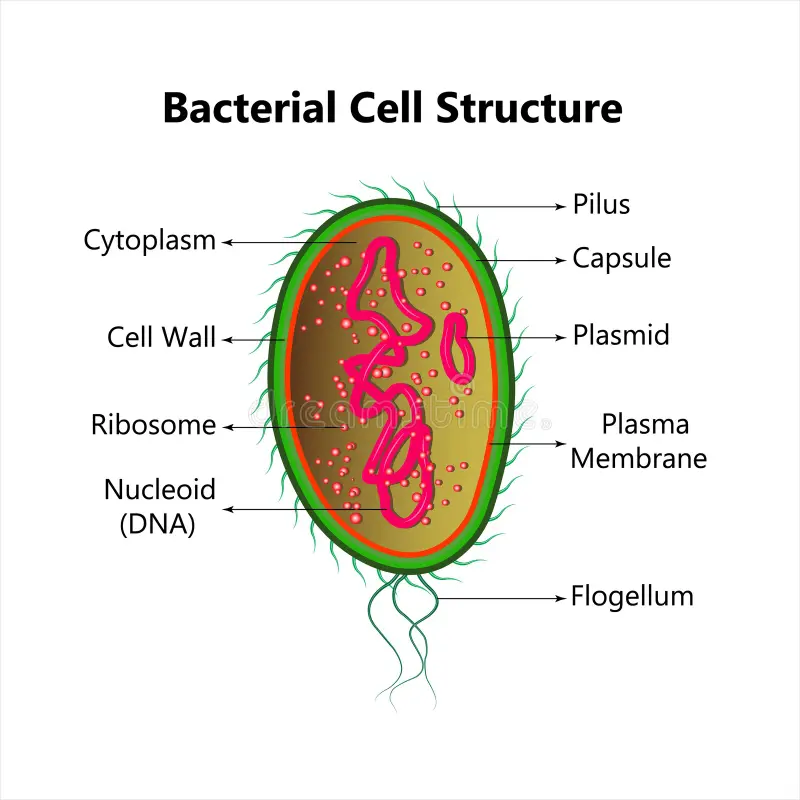
What are the internal structures of a prokaryotic bacterial cell
Internal structures (no membrane-bound organelles) include:
Cytoplasm
Ribosomes
Nucleoid (irregularly shaped region within the cell that contains the genetic material, which is a circular, double-stranded DNA molecule, but is not enclosed by a membrane)
Inclusions
Plasmids
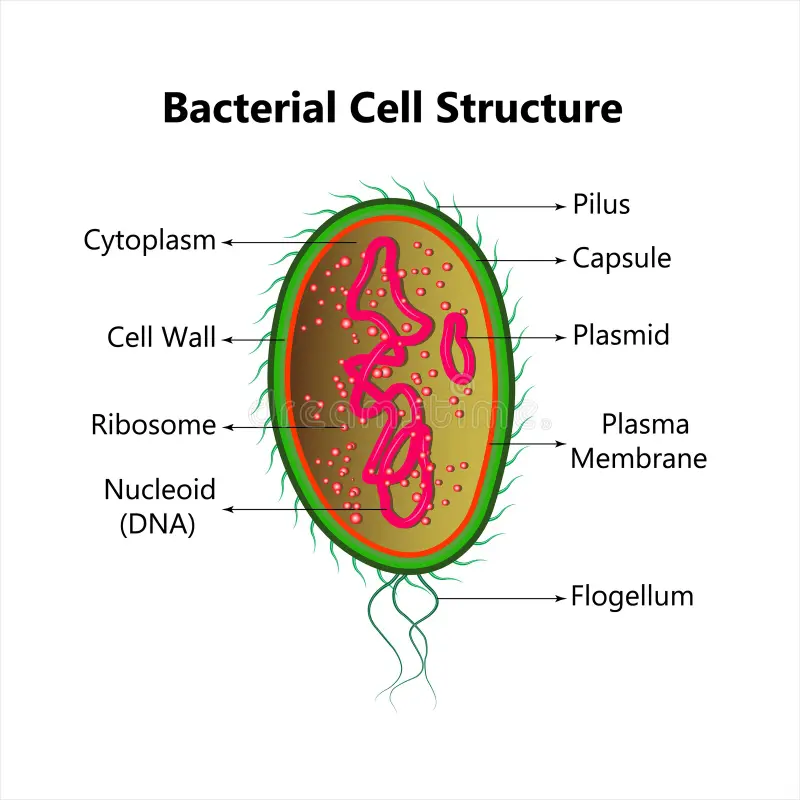
How does the bacterial plasma membrane generate energy
The plasma membrane has invaginations enabling a proton motive force to create energy for the cell.
Prokaryote cells lack mitochondria and need to produce ATP as such.
What is the nucleoid in bacteria?
The nucleoid is diffuse DNA throughout the cell (unlike eukaryotic nuclei), lacking histones but compacted into circular sections via supercoiling with proteins.
Quinolones target supercoling
- DNA is a big molecule and needs to be compacted (in eukaryotes it is compacted by histones).
- In prokaryotes, the DNA is circular (linear in eukaryotes) and the neds are covalently linked together and compacted by super coiling by certain proteins
How does selective drug toxicity target bacterial DNA
Quinolones targets bacterial supercoiled circular DNA (unlike linear eukaryotic chromosomes), preventing damage to human cells."
What are plasmids and their role in bacteria
Plasmids are small, circular & self-replicating DNA sections that can move between cells via pili-aided conjugation
Inserts phenotypes (e.g., drug resistance) through homologous recombination.
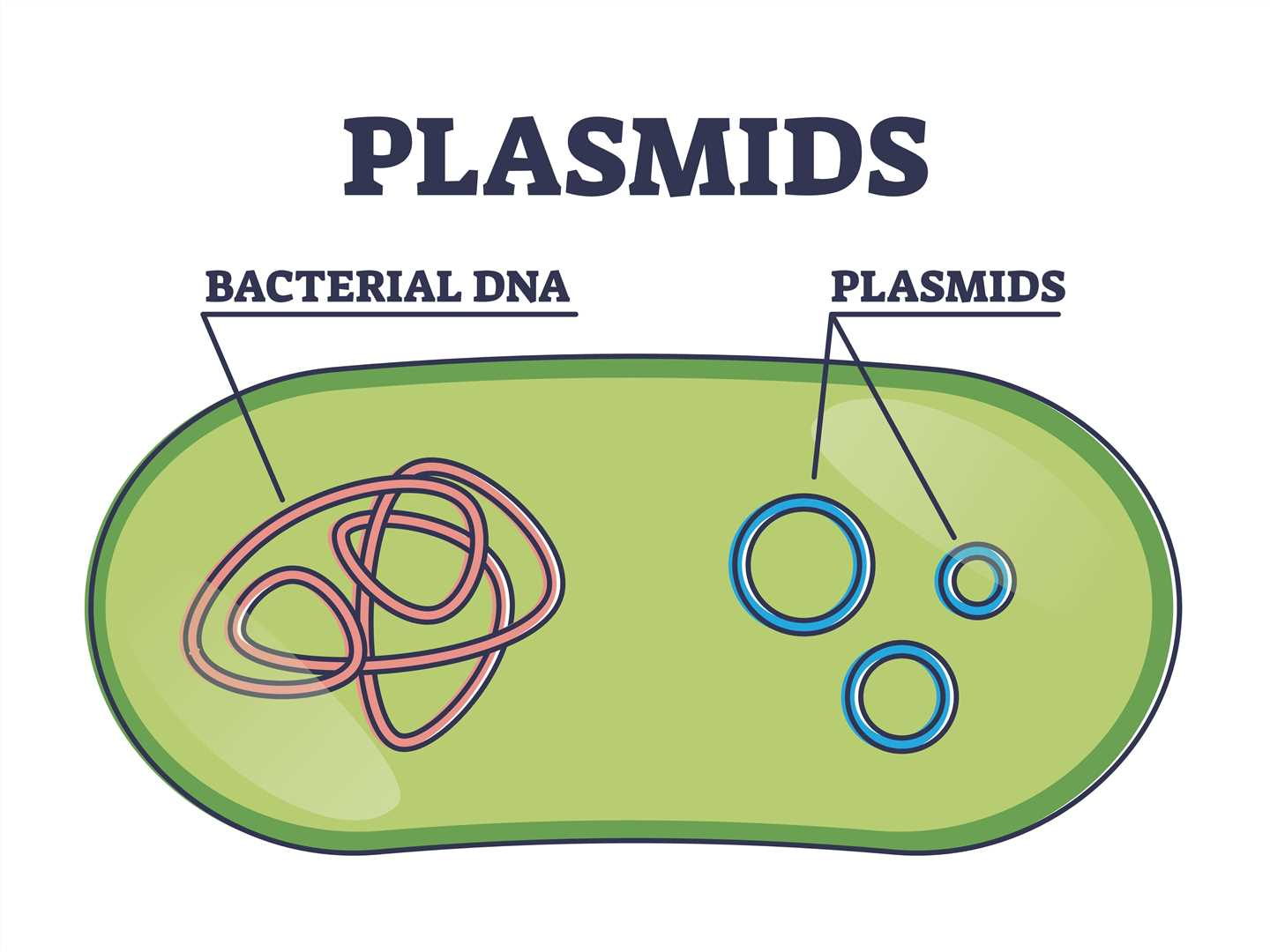
How do bacterial ribosomes differ from eukaryotic ribosomes
Bacterial ribosomes (70S) differ in density and protein formation from eukaryotic ribosomes (80S)
Drug targets by inhibiting peptide bond formation or translocation at P sites.
P site is located on the ribosome where the peptidyl-tRNA [the tRNA carrying the growing polypeptide chain] resides during translation.
What is an endospore and its significance in pharmaceuticals
Dormant bacterial formed under stress, defensive mechanism, when nutrients are poor or generally under stress, bacteria can survive by producing endospores surviving or in extreme conditions (e.g., radiation, heat)
Pharmaceutical concern as it can germinate & proliferate into vegetative cells, requiring checks in medications.
Vegetative cell are usually gram-positive but can be gram-negative,
What is the role of the bacterial plasma membrane
The semi-permeable plasma membrane acts as:
Boundary between cytosol and the outside
Facilitates cell wall biosynthesis (a drug target)
Contains glycolipid carbohydrates.
What are the two common bacterial cell wall types
Gram-Positive: thick peptidoglycan layer, smaller periplasmic layer
Gram-Negative: thin peptidoglycan layer, larger periplasmic layer with lipopolysaccharide (LPS).
What are gram-variable and non-staining bacteria
Gram-variable bacteria show inconsistent staining
Non-staining endoparasitic bacteria (e.g., Chlamydia) resist standard Gram staining.
What is the composition of peptidoglycan in bacterial cell walls
Peptidoglycan consists of:
NAM (N-acetylmuramic acid) or NAG (N-acetylglucosamine)
With alternating L and D isomers [Alanine, Glutamic acid, diaminopimelic acid(DAP) and Alanine]
Cross-linked by peptide interbridges made up of glycine residues (pentapeptide bridge) or direct covalent links between NAM subunits terminal D-alanine and DAP
DIRECT, covalent link - = Gram-negative cell wall
PEPTIDE INTERBRIDGE = Gram-positive cell wall
What is the gram-negative cell envelope
Includes an LPS (Lipopolysaccharide) layer with an outer sugar chain
Lipid A (endotoxin) anchored in the membrane, released upon cell death causing septic shock.
Why should bactericidal drugs be avoided for gram-negative infections
"Bactericidal drugs kill gram-negative bacteria, releasing Lipid A endotoxins and risking septic shock; bacteriostatic drugs are preferred to inhibit growth without lysis."
What external components form glycocalyces in bacteria
"Glycocalyces (capsules and biofilms) are mucus-secreting structures (e.g., in E. coli causing UTIs) that form biofilms, aiding attachment and resistance against gravity."
How do microbes grow via binary fission
"Microbes grow by binary fission, splitting into two cells, which can double repeatedly in a logarithmic pattern based on nutrient availability and conditions."
What are the phases of the bacterial growth curve?
1. Lag phase: Preparation for division with energy transduction.
2. Exponential growth: Rapid logarithmic increase.
3. Stationary phase: Plateau as nutrients deplete.
4. Death phase: Cell decline.
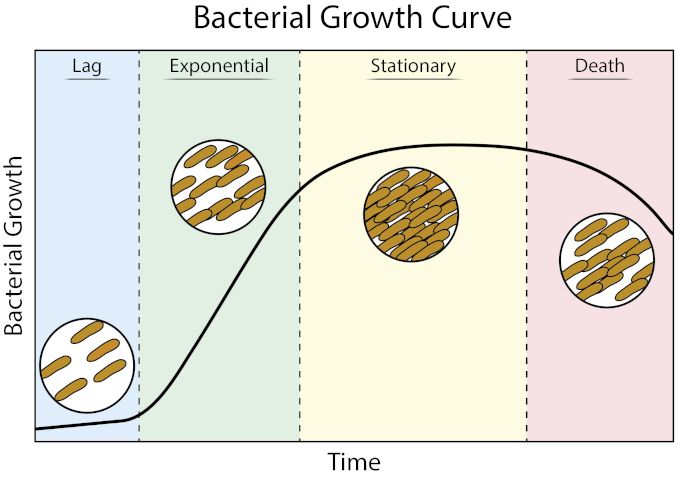
What is the formula for bacterial population growth
N = N₀ × 2ⁿ
Where N is the population after n doublings, N₀ is the initial population, and n is the number of generations.
How is the number of bacterial generations (n) calculated
n = (log Nₜ - log N₀) / log 2 = (log Nₜ - log N₀) / 0.301
Where Nₜ is the population at time t
N₀ is the initial population
log 2 ≈ 0.301
What is the mean growth rate constant (k) in bacteria
k = n / t = (log Nₜ - log N₀) / (0.301 × t)
Representing the number of generations per unit time (e.g., per hour) in a batch culture.
How is the mean generation time (g) derived from the growth rate constant (k)
g = 1 / k
Where g is the mean generation time (doubling time), calculated as the reciprocal of k when Nₜ = 2N₀ (population doubles).
How do you calculate k when the population doubles
k = (log (2N₀) - log N₀) / (0.301 × g)
= log 2 / (0.301 × g)
= 1 / g
showing k as the inverse of the doubling time.
How do you calculate the mean generation time (g) for a population growing from 10³ to 10⁹ cells/mL in 10 hours
n = (log 10⁹ [FINAL] - log 10³[INITIAL]) / 0.301 = (9 - 3) / 0.301 = 6 / 0.301 ≈ 19.93 generations # [number of bacterial generations (n)]
k = n / t = 19.93 / 10 ≈ 1.993 per hour # [no. generations per unit of time (k)]
g = 1 / k = 1 / 1.993 ≈ 0.502 hours (30.1 minutes). # [mean generation time (g)]
THREE EQs to mainpulate!

